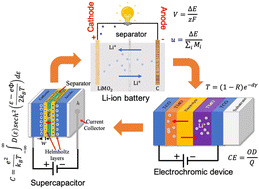Ab initio methods for the computation of physical properties and performance parameters of electrochemical energy storage devices
Abstract
With the rapid development of electric vehicles and mobile technologies, there is a high demand for electrochemical energy storage devices and electrochemical energy conversion devices. Devices meeting these needs include metal-ion batteries (MIBs), supercapacitors (SCs), electrochromic devices (ECDs), and multifunctional devices such as electrochromic batteries and supercapatteries. Currently, the goal has been the enhancement of operational parameters and physical properties that results in a higher performance of these devices. In the case of batteries, SCs, and supercapatteries, scientists seek to improve the equilibrium voltage, energy density, power, capacitance, and charge rate. In the case of ECDs, the focus is on improvement of the optical modulation and coloration efficiency. However, synthesis and characterization of new materials, or of materials with optimized properties, is time consuming and highly expensive. Computational simulation of materials can expedite the experimental endeavor by modelling novel atomic structures and predicting device performance. This is possible using ab initio theories and applying physical principles that allow us to understand the underlying mechanisms governing the behavior of materials in these devices. Taking as a point of departure density functional theory (DFT), in this review, we discuss the first principles methods used for the computation of physical properties and performance parameters of electrochemical energy storage devices. A wide coverage of DFT is given, dealing with the strengths and weaknesses of the most popular functionals used in the field of electrochemical energy storage. With these tools, ab initio methods for the computation of basic properties such as effective mass, mobility, optical band gap, transmissivity, conductivity (ionic and electronic), and criteria for structure stability (cohesive energy, formation energy, adsorption energy, and phonon frequency) are addressed. We also highlight the first principles techniques for the calculation of performance parameters in MIBs, SCs, and ECDs.

- This article is part of the themed collection: 2023 PCCP Reviews


 Please wait while we load your content...
Please wait while we load your content...